Abstract
Background: Cellobiose dehydrogenases have gained interest due to their potential applications in sectors from biofuel production to biomedical devices. The CDHIIA variant is comprised of a cytochrome domain (CYT), a dehydrogenase domain (DH), and a carbohydrate-binding module (CBM) that are connected by two flexible linkers. Upon cellobiose oxidation at the DH, intramolecular electron transfer (IaET) occurs from the DH to the CYT. In vivo, CDHIIA CYT subsequently performs intermolecular electron transfer (IeET) to a lytic polysaccharide monooxygenase (LPMO). The relevant solution-state CDH domain conformations for IaET and IeET have not been fully characterized.
Methods: Small-angle X-ray and neutron scattering measurements of oxidized CDHIIA from Myriococcum thermophilum and Neurospora crassa were performed to investigate the structural landscape explored in solution by MtCDHIIA and NcCDHIIA in response to cations, pH, and the presence of an electron acceptor, LPMO9D from N. crassa.
Results: The scattering data complemented by modeling show that, under oxidizing conditions, MtCDHIIA undergoes global conformational rearrangement in the presence of Ca2+. Oxidized NcCDHIIA exhibits conformational changes upon pH variation and, in the presence of NcLPMO9D, primarily adopts a compact conformation.
Conclusions: These results demonstrate different conformational responses of oxidized MtCDHIIA and NcCDHIIA to changes in environment. The results also reveal a shift in the oxidized NcCDHIIA conformational landscape toward interdomain compaction upon co-incubation with NcLPMO9D.
General significance: The present study is the first report on the structural landscapes explored in solution by oxidized cellobiose dehydrogenases under various cation concentrations, pH conditions and in the presence of an electron-accepting LPMO.




